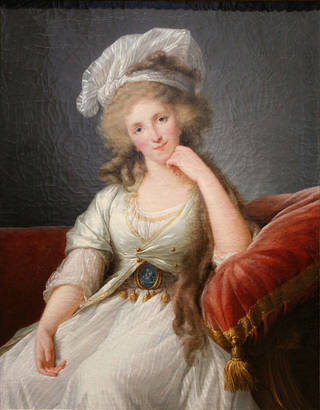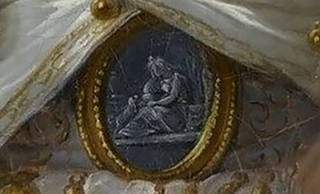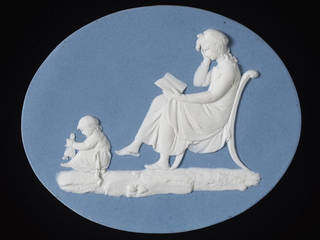Jewellery inspired by books and films is easy to find today – from a copy of the One Ring from the Lord of the Rings trilogy and jewels inspired by Game of Thrones, to various Harry Potter inspired necklaces, earrings and bracelets. The literary enthusiast has plenty to choose from.
Readers in the 18th century – the period when the novel began its unstoppable rise – also wanted to show their love of favourite characters whilst demonstrating their sensibility and involvement in popular culture.
The novels of the Irish writer Laurence Sterne, now best remembered for Tristram Shandy, were enormously popular across Europe. Scenes from his books were reproduced in paintings and engravings, on decorated snuff boxes and fans, and were made into cameos for brooches, buckles, rings and earrings.

The figures of 'Poor Maria' and the 'Bourbonnais Shepherd', seen in a pair of plaques made for shoe or knee buckles by Wedgwood, were based on Sterne's 1768 novel A Sentimental Journey through France and Italy, published a few weeks before his death. It was one of the bestsellers of its day, with Sterne's near contemporary Matthew Carey claiming that:
Few works if any, were ever received with more unbounded applause, than the Sentimental Journey. Its circulation was immense. It produced a revolution in the popular taste.
This popularity inspired paintings of Maria – most influentially, Angelica Kauffman's Maria of Moulines of 1779 – but also versions by painters such as Joseph Wright and Charles Landseer. The young Maria met Yorick, the protagonist of the book, when mourning her late husband "sitting under a poplar [...] with her elbow in her lap […] and her head leaning on one side […] dressed in white". She was usually shown with her little dog Sylvio, a symbol of fidelity, standing in for her lost lover.

The Shepherd only makes a passing appearance in the text, described as "the roughest peasant who traverses the bleakest mountain", but he provides a useful foil to the lovelorn and pitiable Maria. Shepherd and shepherdess figures appealed to a romantic sensibility, acting as totems of a simpler, picturesque life. The French queen Marie Antoinette was even known to dress up as a shepherdess when spending time at her Versailles playhouse, the Petit Trianon. Sterne himself dedicated his novel Tristram Shandy to a shepherd sitting with his faithful dog, to introduce "an entire new set of objects to his Imagination" and hence provide "a Diversion to his passionate and love-sick Contemplations".

Josiah Wedgwood used the figures of the Shepherd and Maria in his ceramic cameos and predicted they would form 'a capital business'. He had perfected the formula for jasperware in the late 1770s at the Etruria works in Birmingham, producing finely modelled pure white cameos on a tinted ground which were set in brooches, rings, necklaces, shoe buckles and earrings. Many designs used fashionable Neo-classical scenes of Gods and Goddesses, whilst others depicted contemporary figures and political causes, such as the campaign to abolish slavery. A number of cameo designs – including those for Maria and the Shepherd – were created by Lady Templetown, who often began with a silhouette in "beautiful cut Indian paper". Wedgwood jewellery was frequently set in cut steel mounts made by friend and fellow Birmingham entrepreneur, Matthew Boulton.

The glittering steel mounts and colourful cameo brooches were often pinned on the neckline, waist or shoulders of lightly coloured, softly draped dresses and tunics inspired by classical statues. On the eve of the French Revolution in 1789, Marie Adélaïde, the Duchess of Orléans was painted by Elisabeth Vigée Le Brun wearing a simple muslin dress with a large cameo of Poor Maria at her waist – showing the popularity of the book across the courts of Europe.

Marie Adélaïde was described as "...always wearing a melancholic expression which nothing could cure. She sometimes smiled, she never laughed". Although a melancholic pose was a fashionable way to be painted, she had good reasons to appear sad – separated from her husband after a personal and political estrangement, she had also lost custody of her children. Perhaps this attracted her to the figure of the abandoned and grieving Maria?
Romantic young people longed to identify themselves with Maria and Yorick – Lady Emma Hamilton, mistress to Admiral Nelson, was said to have depicted herself as Maria, with Nelson as her admirer Yorick, in a needlework picture now in the collections of the National Maritime Museum, London. Society was nevertheless alert to the dangers of reading novels and developing an excessive romantic sensibility. This fear was gently mocked by Jane Austen who later used her heroine Catherine Morland’s addiction to Gothic novels to comic effect in Northanger Abbey, causing the over-imaginative Catherine to accuse her host of murder.

Wearing ‘Poor Maria’ at your waist was an elegant fashion statement, but life didn't follow literature – Emma Hamilton finished her days in poverty, whilst the court life known by Marie Adélaïde was swept away by the furies of the French Revolution.


